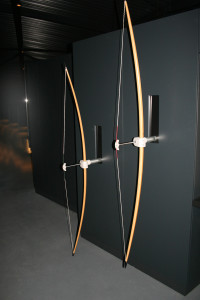Artem SFX, an award-winning physical special effects company, has developed and built a pair of interactive longbows to be included in the new Mary Rose Museum which recently opened to the public at Portsmouth Historic Dockyard. It is one of the many interactives available within the museum.
The Mary Rose Trust’s exhibition coordinator, Nick Butterley, along with his interactive designer Richard Glassborow, approached Artem’s exhibitions’ department headed up by Alex Phillips requesting an upgraded replacement for a popular exhibit that had been housed inside the old museum.
 These interactive bows are new – the challenge was to bring to life how the original bows worked. With a pull of around 80 pounds (36 kilograms) for the adult bow, the longbows are mounted against a display case, with a rise and fall element that allows the arrow to be lifted to eye level. The bow floats in a mid-position so that the ‘archer’ can push the bow away as well as pulling the string, allowing them to really feel what it was like to use the longbow.
These interactive bows are new – the challenge was to bring to life how the original bows worked. With a pull of around 80 pounds (36 kilograms) for the adult bow, the longbows are mounted against a display case, with a rise and fall element that allows the arrow to be lifted to eye level. The bow floats in a mid-position so that the ‘archer’ can push the bow away as well as pulling the string, allowing them to really feel what it was like to use the longbow.
Often termed ‘the medieval machine gun’ the longbow was one of the most lethal anti-personnel weapons of its time requiring great strength and skill to operate. Measuring between six and seven feet, the sheer volume of arrows which could be shot and the rate of shooting made archers a vital component in any battle, including the Battle of the Solent during which the Mary Rose sank. Artem and the Mary Rose Museum wanted to give visitors an idea of the strength and skill required to actually use such a powerful weapon. In the adjacent display cases there are many of the 138 original longbows, ready to be used in battle, that sank with the ship almost 500 years ago.
The Mary Rose, Henry VIII’s infamous warship, sank in 1545 and was raised from the seabed in 1982. Over 19,000 artefacts were recovered with it – including weapons, clothing, domestic and personal possessions and environmental and human remains and clothes. £23 million was awarded by the Heritage Lottery Fund to the Mary Rose Trust to help build the new state-of-the-art Mary Rose Museum and to complete the conservation of the ship's remains and cargo.
Most recently, the Artem exhibitions’ department has worked for the Glasgow Riverside Transport Museum. They have also previously worked at Portsmouth Historic Dockyard, where they created a selection of interactive displays in the Action Stations gallery. Artem, which celebrates its 25th anniversary this year, worked extensively on the Olympic and Paralympic opening and closing ceremonies in 2012.






